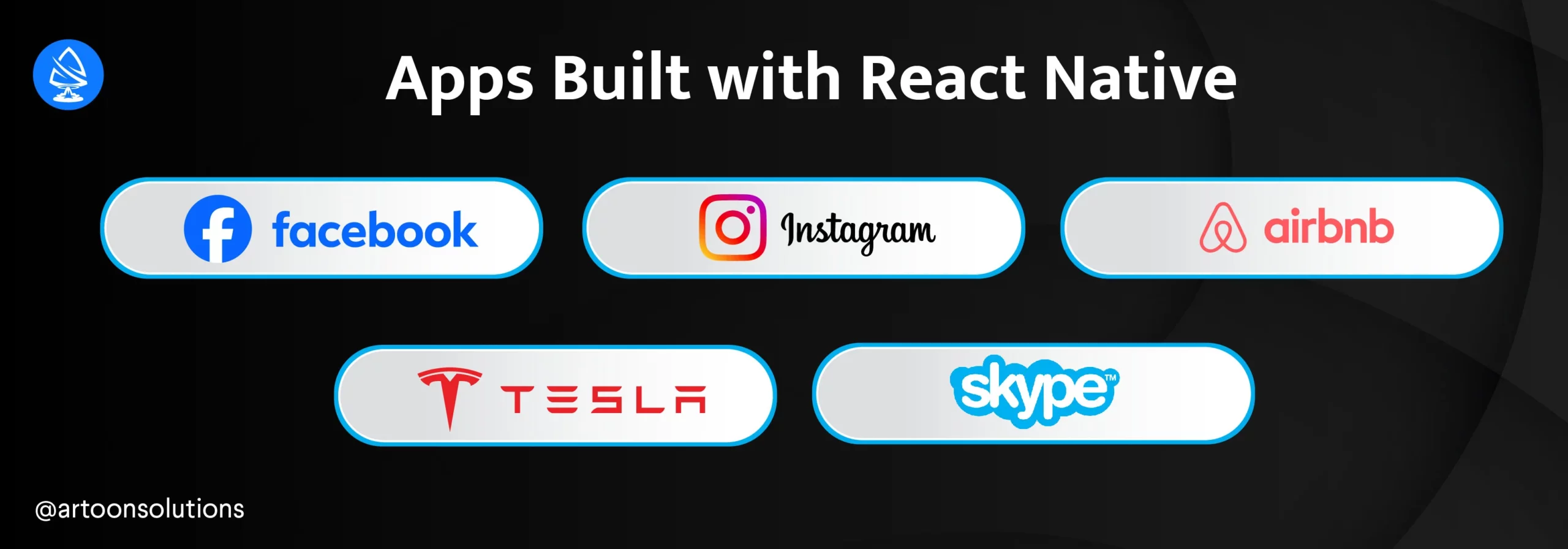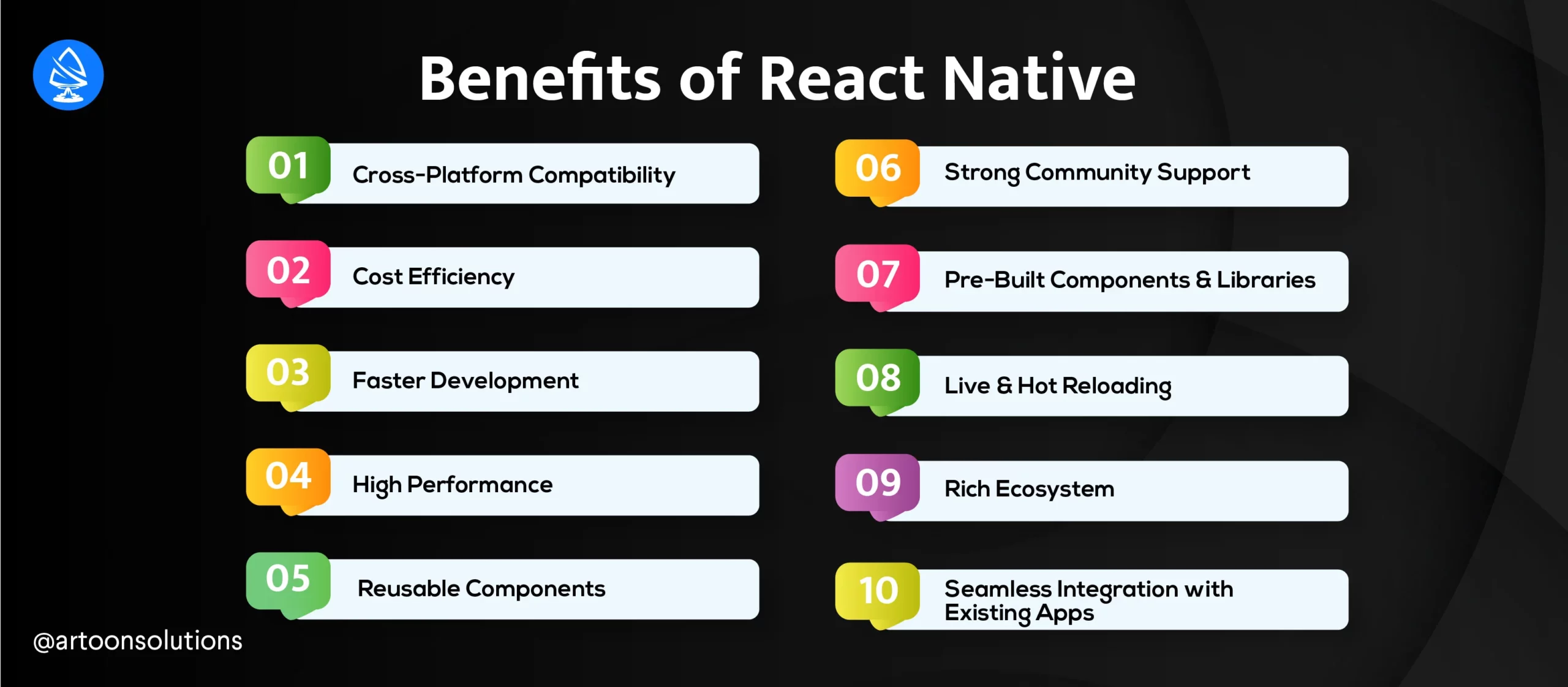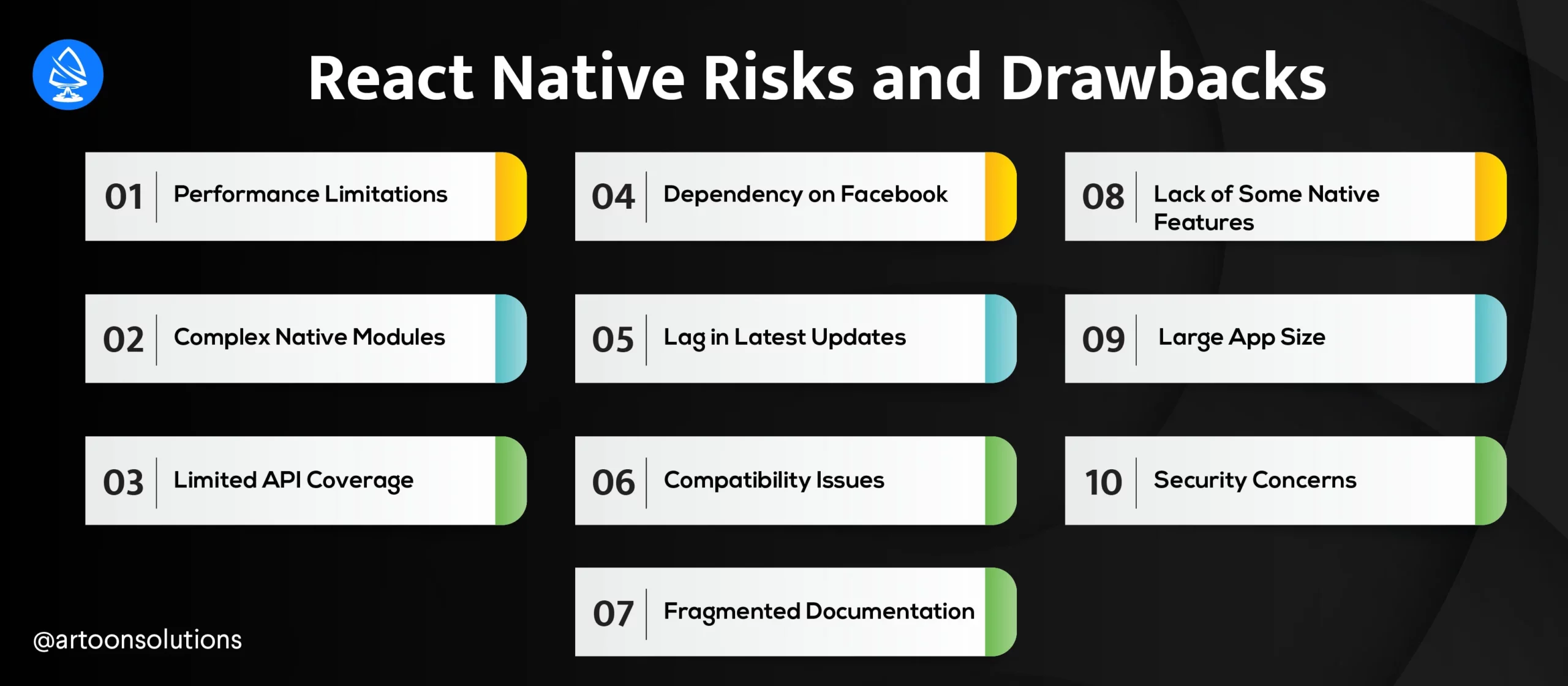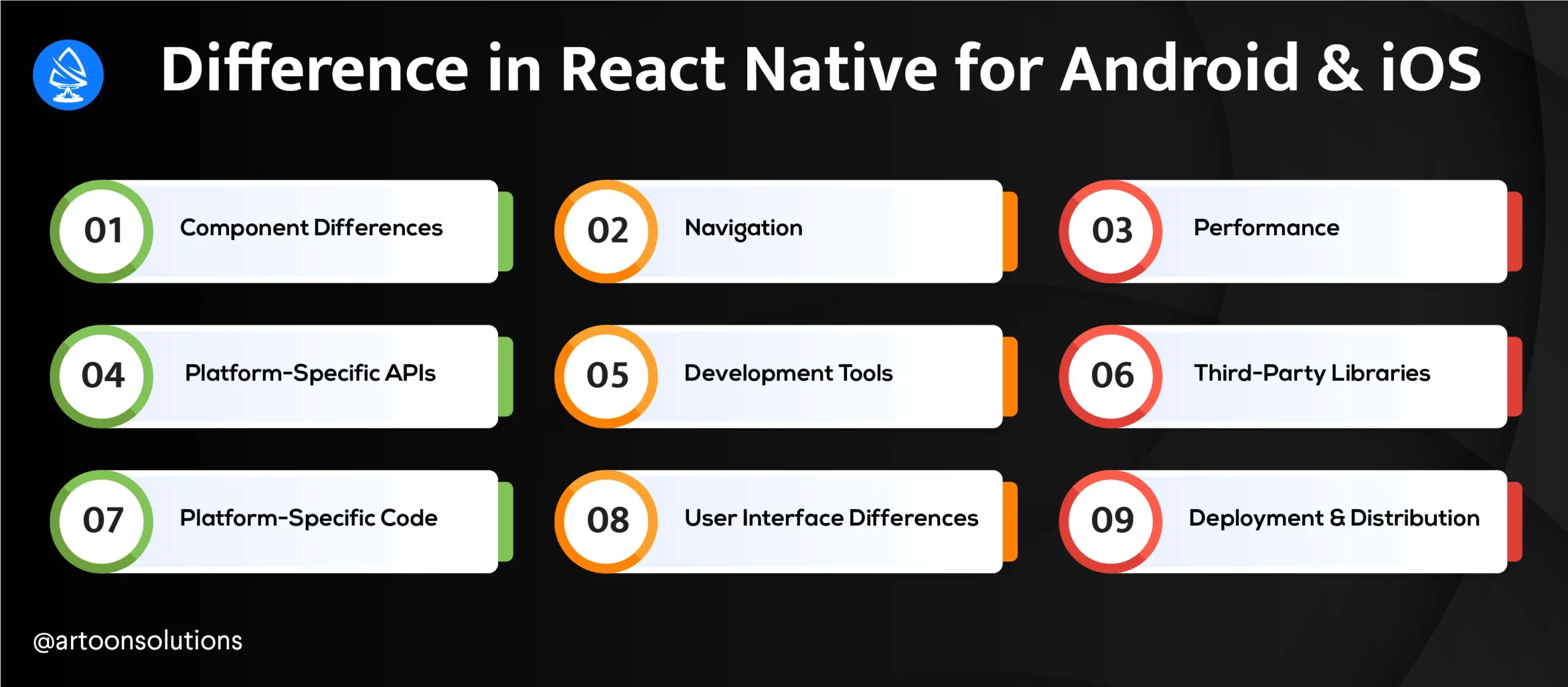Inquisitive about what’s React Native and the way it can revolutionize cross platform cell app growth? In 2024, React Native continues to face out as a game-changing framework that enables builders to create highly effective cell functions for each iOS and Android platforms utilizing a single codebase. Confused between Flutter vs React Native? Let’s discover why React Native is the popular selection for constructing high-performance, cross-platform cell apps. Let’s dive in!
What’s React Native?


React Native is an open-source framework developed by Fb that allows builders to create cell functions for each iOS and Android platforms utilizing a single codebase. Launched in 2015, React Native software has gained vital reputation attributable to its effectivity and efficiency, permitting builders to leverage the facility of JavaScript together with React, a well-liked library for constructing consumer interfaces.
Core Idea of React Native
The core idea behind React Native is “be taught as soon as, write wherever.” Because of this builders can write code in JavaScript and deploy it on a number of platforms with no need to be taught separate languages or frameworks for iOS and Android. React Native achieves this through the use of native parts as an alternative of internet parts as constructing blocks, offering a extra genuine and high-performance consumer expertise.
How It Differs from Conventional Cell Improvement
Conventional cell app growth includes utilizing completely different programming languages relying on the platform. For iOS apps, builders usually use languages like Swift or Goal-C, whereas for Android apps, languages corresponding to Java or Kotlin are generally used. Every platform has its personal set of instruments, libraries, and growth environments, which might result in elevated growth effort and time, particularly when sustaining two separate codebases.
In distinction, If you wish to create a React Native app, React Native simplifies this course of by permitting builders to write down most of their code as soon as and run it throughout each platforms. This not solely quickens the event course of but in addition makes it simpler to keep up and replace the app. Nonetheless, it’s necessary to notice that some platform-specific code should still be vital for sure options or efficiency optimizations.
Be taught Extra: React Native Paper
How Does React Native Work?


React Native operates by bridging the hole between JavaScript and native cell platforms. Let’s take a simplified overview of how React Native capabilities:
1. JavaScript Core:
React Native app growth makes use of JavaScript to write down nearly all of the appliance code. This code runs in a JavaScript engine, separate from the principle UI thread.
2. Bridge:
A key characteristic of React Native is its “bridge,” which acts as a connection between the JavaScript code (which builders write) and the native parts of the cell system (like buttons, textual content fields, and animations). The bridge permits JavaScript directions to be despatched to the native platform and vice versa.
3. Native Elements:
As a substitute of rendering WebViews or HTML parts, React Native renders actual native parts. It implies that the appliance seems and behaves similar to a daily native app. It runs easily and supplies customers with the acquainted expertise they count on from apps designed particularly for his or her gadgets.
4. Threading:
React Native separates the JavaScript thread from the principle UI thread. This separation ensures that the UI stays responsive, as JavaScript code execution doesn’t block the rendering of the UI.
5. Modules and APIs:
React Native app growth supplies a wide range of modules and APIs that permit JavaScript to work together with native functionalities just like the digicam, location providers, and different device-specific options. Customized native modules may also be written if particular performance just isn’t out there out of the field.
Via this structure, React Native permits builders to construct high-performance, cross-platform cell functions utilizing a single codebase, bridging the effectivity of JavaScript with the capabilities of native cell platforms.
Apps Constructed with React Native


React Native app growth has been adopted by quite a few corporations to construct high-performance, dependable cell functions. Listed here are some notable examples:
1. Fb
Fb, the creator of React Native, makes use of it extensively in its personal app. The framework was developed to streamline Fb’s cell app growth, permitting for fast iteration and a unified codebase throughout platforms.
2. Instagram
Instagram built-in React Native into their current native app beginning with the Push Notifications view. The transition was easy, demonstrating React Native’s functionality to seamlessly combine with current apps and share code throughout platforms, considerably rushing up the event course of.
3. Airbnb
Airbnb used React Native to handle and preserve their cell functions. Though they later moved again to native growth attributable to particular challenges, their expertise showcased React Native’s potential to deal with advanced options and improve growth pace throughout its utilization.
4. Tesla
The Tesla app, used to regulate their automobiles and Powerwall, is constructed with React Native. This app permits Tesla house owners to entry their automobiles from wherever, displaying the facility of React Native to ship a responsive, real-time software for a high-tech viewers.
5. Skype
Skype underwent a serious redesign and selected React Native to rebuild their cell app. The goal was to offer a constant consumer expertise throughout all platforms, and React Native helped Skype obtain a unified and easy efficiency on each iOS and Android.
Advantages of React Native


React Native app growth affords quite a few benefits that make it a well-liked selection for cross-platform cell app growth. Let’s discover a few of the key advantages of React Native:
1. Cross-Platform Compatibility
Some of the vital advantages of the app in React Native is its potential to run on each iOS and Android platforms utilizing a single codebase. This cross-platform compatibility saves a number of money and time throughout growth as a result of builders solely want to write down one set of code that works on a number of platforms, fairly than writing separate code for every platform.
2. Price Effectivity
Since React Native app growth permits for a shared codebase, corporations can save on hiring separate growth groups for iOS and Android. This discount within the want for distinct platform-specific sources interprets to decrease total growth and upkeep prices.
3. Quicker Improvement
React Native’s scorching reloading characteristic permits builders to see the outcomes of the most recent change instantly, with out rebuilding your complete app. This quickens the event cycle, permitting for faster iterations and quicker time-to-market.
4. Excessive Efficiency
React Native app growth makes use of native parts and modules, guaranteeing that apps constructed with it carry out virtually in addition to native apps. The framework talks to the system’s built-in options and makes use of its personal manner of displaying issues on display screen, which makes the app run easily and reply shortly, giving customers an excellent expertise.
5. Reusable Elements
React Native app growth permits builders to reuse parts throughout completely different tasks, enhancing productiveness. This modular structure makes it simple to keep up and replace code, fostering higher collaboration and lowering redundancy.
6. Robust Group Help
As an open-source framework backed by Fb, React Native has a big and energetic group. This group assist implies that builders have entry to a wealth of sources, libraries, instruments, and shared information, making problem-solving and growth extra environment friendly.
7. Pre-Constructed Elements and Libraries
React Native affords a variety of pre-built parts and third-party libraries, which could be simply built-in into functions. These parts and libraries assist in accelerating growth, lowering the necessity for customized options for frequent functionalities.
8. Stay and Scorching Reloading
React Native app growth helps reside and scorching reloading, which permits builders to inject new variations of information at runtime with out the necessity for a full reload. This characteristic is especially helpful for making fast adjustments and debugging, enhancing the event expertise.
9. Wealthy Ecosystem
The wealthy ecosystem of React Native contains quite a few instruments and plugins that simplify varied facets of growth, from testing to debugging to UI design. This complete ecosystem helps builders in constructing strong and feature-rich functions effectively.
10. Seamless Integration with Current Apps
React Native could be built-in into current native functions, permitting groups to incrementally undertake the framework with out the necessity for a whole rewrite. This flexibility is right for large-scale functions trying to profit from React Native’s benefits whereas sustaining legacy methods.
11. Robust Developer Tooling
React Native affords highly effective developer instruments, together with the React Developer Instruments and Chrome Developer Instruments, which give strong debugging and profiling capabilities. These instruments assist builders diagnose points, optimize efficiency, and enhance code high quality.
React Native Dangers and Drawbacks


Whereas React Native affords quite a few advantages, it’s necessary to pay attention to its potential dangers and downsides. Listed here are some key concerns:
1. Efficiency Limitations
Though React Native app carry out effectively for many use circumstances, they may not match the efficiency of totally native apps, significantly for CPU-intensive duties like advanced animations or heavy computational logic. Native code usually runs quicker and extra effectively, which could be essential for high-performance functions.
2. Complicated Native Modules
Whereas React Native supplies a number of out-of-the-box performance, some options would possibly nonetheless require customized native modules. Writing these modules requires experience in native programming languages (Java/Kotlin for Android and Goal-C/Swift for iOS), doubtlessly complicating growth and upkeep.
3. Restricted API Protection
React Native doesn’t cowl all native APIs, which suggests some options is perhaps inaccessible or require extra effort to implement. Builders would possibly must create customized bridges to entry sure functionalities, including to the complexity and growth time.
4. Dependency on Fb
Since React Native is created and managed by Fb, it depends on the corporate’s ongoing assist and steering. Whereas Fb’s involvement typically advantages the framework, adjustments within the firm’s priorities or technique might affect the framework’s future.
5. Lag in Newest Updates
React Native would possibly lag in supporting the most recent options and updates of the iOS and Android working methods. Native growth environments usually have fast entry to the most recent SDKs, whereas React Native would possibly want time to include new functionalities.
6. Compatibility Points
Completely different variations of React Native and its dependencies can generally trigger compatibility points. Managing these dependencies and guaranteeing that each one modules work seamlessly collectively could be difficult, particularly for big tasks with a number of dependencies.
7. Fragmented Documentation
Though React Native has intensive documentation, it might generally be fragmented or outdated, significantly for third-party libraries and modules. Builders could discover themselves counting on group assist and boards to resolve points not coated within the official documentation.
8. Lack of Some Native Options
Sure platform-specific options will not be out there or totally supported in React Native, limiting the power to leverage the total potential of the native platform. This generally is a vital disadvantage for apps that must make the most of superior native options extensively.
9. Massive App Measurement
React Native app can have bigger binary sizes in comparison with totally native apps, as a result of inclusion of the JavaScript runtime and different dependencies. This bigger dimension can affect obtain instances and cupboard space on customers’ gadgets.
10. Safety Considerations
JavaScript is extra weak to sure sorts of assaults in comparison with native code. Whereas React Native app have safety measures in place, builders must be additional cautious to make sure their apps are safe, particularly for functions that deal with delicate information.
11. Group Reliance
Whereas the sturdy group assist is a profit, it additionally implies that builders could rely closely on community-contributed libraries and options. The standard and upkeep of those third-party libraries can fluctuate, resulting in potential reliability points.
Variations in React Native for Android & React Native for iOS


React Native app growth goals to offer a unified growth expertise for constructing cell apps throughout each Android and iOS platforms. Nonetheless, as a result of inherent variations between the 2 working methods, builders could encounter some variations in how React Native software behaves and is carried out for every. Listed here are some key variations:
1. Part Variations
Design and Structure: React Native Android and React Native iOS have completely different design pointers and conventions. As an illustration, the default conduct and look of parts like buttons, navigations, and tab bars can fluctuate considerably. React Native supplies platform-specific parts (e.g., ToolbarAndroid, ProgressViewIOS) to cater to those variations.
Styling: Whereas React Native makes use of a constant styling method throughout platforms, sure kinds would possibly render otherwise on React Native Android and React Native iOS. Builders usually want to use platform-specific styling utilizing the Platform module to realize constant seems.
2. Navigation
Navigation Libraries: Navigation dealing with can differ attributable to platform-specific behaviors. Libraries like React Navigation work throughout each platforms, however there is perhaps variations in how transitions and gestures are carried out. As an illustration, iOS usually makes use of swipe gestures for navigation, whereas Android usually makes use of a again button.
3. Efficiency
Listing Views: Elements like FlatList and SectionList carry out effectively on each platforms, however Android could require extra optimization for advanced lists attributable to variations in how the 2 platforms deal with rendering.
Animations: Whereas React Native supplies a unified API for animations, efficiency would possibly fluctuate. Android would possibly want extra optimization for smoother animations attributable to variations within the native rendering engines.
4. Platform-Particular APIs
Native Modules: Sure functionalities require platform-specific native modules. As an illustration, accessing Google Match information would possibly require Android-specific modules, whereas integrating with Apple HealthKit requires iOS-specific modules. Builders would possibly want to write down customized native code for platform-specific options.
Permissions: Dealing with permissions can differ considerably. Android makes use of a granular permission mannequin launched in Android 6.0 (Marshmallow), whereas iOS permissions are dealt with at a better degree. React Native supplies APIs to deal with permissions throughout each platforms, however the implementation particulars differ.
5. Improvement Instruments
Construct Instruments: React Native Android makes use of Gradle for constructing functions, whereas React Native iOS makes use of Xcode. Builders must be aware of each units of instruments to successfully handle and troubleshoot platform-specific points.
Debugging: Whereas instruments like Reactotron and the built-in React Native Debugger work throughout each platforms, sure debugging practices would possibly differ. For instance, Android builders would possibly use Android Studio’s profiling instruments, whereas iOS builders depend on Xcode’s devices.
6. Third-Celebration Libraries
Library Help: Some third-party libraries may need higher assist or options for one platform over the opposite. It’s necessary to verify the compatibility and have parity of libraries throughout each platforms earlier than integrating them into your venture.
7. Platform-Particular Code
Conditional Rendering: Utilizing the Platform module, builders can write conditional code to deal with platform-specific logic. For instance:
| import { Platform } from ‘react-native’; const directions = Platform.choose({ ios: ‘Press Cmd+R to reload,\nCmd+D or shake for dev menu’, android: ‘Double faucet R in your keyboard to reload,\nShake or press menu button for dev menu’, }); |
8. Consumer Interface Variations
Contact Suggestions: React Native iOS and React Native Android deal with contact suggestions otherwise. iOS has a default “spring” animation on contact, whereas Android makes use of a ripple impact. React Native supplies parts like TouchableOpacity and TouchableNativeFeedback to handle these variations.
Protected Space: iOS requires dealing with secure areas, particularly with gadgets having notches (like iPhone X and later). React Native supplies the SafeAreaView part to deal with this, which is much less of a priority on most Android gadgets.
9. Deployment and Distribution
App Retailer vs. Google Play: The processes for deploying apps to the Apple App Retailer and Google Play Retailer have completely different necessities and pointers. Builders want to pay attention to these variations to make sure a easy submission and approval course of.
React Native – Finest Cross Platform Cell App Improvement
Within the cross platform cell app growth, React Native stands out as a number one framework. Its mixture of effectivity, efficiency, and developer-friendly options makes it a well-liked selection amongst builders and firms alike. Let’s discover why React Native is usually thought-about the best choice for cross-platform cell app growth.
1. Single Codebase for A number of Platforms
React Native permits builders to write down one codebase that works on each iOS and Android. This considerably reduces growth time and prices, as there is no such thing as a want to keep up separate codebases for every platform. The power to share code throughout platforms additionally simplifies updates and upkeep.
2. Excessive Efficiency
React Native bridges the hole between internet and native functions through the use of native parts. In contrast to hybrid frameworks that depend on WebViews, React Native renders UI parts utilizing native APIs, offering a smoother and extra responsive consumer expertise comparable to totally native apps.
3. Wealthy Ecosystem and Group Help
React Native app ecosystem advantages from a sturdy ecosystem and robust group assist. With a wealth of libraries, instruments, and plugins out there, builders can simply lengthen the performance of their apps. The energetic group additionally implies that builders can shortly discover options to frequent issues and keep up to date with greatest practices.
4. Scorching Reloading
One of many standout options of React Native app growth is scorching reloading. This characteristic permits builders to immediately see the results of code adjustments with out restarting your complete software. Scorching reloading quickens the event course of and enhances productiveness by permitting for real-time suggestions and iterative growth.
5. Modular Structure
React Native’s modular structure permits builders to divide the code into smaller, reusable modules. This modularity not solely makes the codebase extra manageable and scalable but in addition promotes higher collaboration inside growth groups. Completely different crew members can work on completely different modules concurrently with out inflicting conflicts.
6. Robust Backing by Fb
React Native is maintained by Fb, which ensures steady growth and assist. Fb’s dedication to the framework implies that it’s recurrently up to date with new options, bug fixes, and efficiency enhancements. The involvement of a serious tech firm supplies confidence within the framework’s longevity and reliability.
7. Entry to Native Options
React Native app growth supply entry to native system capabilities just like the digicam, GPS, and sensors by means of native modules and third-party libraries. This permits builders to construct feature-rich functions that leverage the total capabilities of the system. When vital, builders can even write customized native code to entry particular functionalities not coated by React Native.
8. Consistency Throughout Platforms
React Native promotes a constant consumer expertise throughout completely different platforms. Through the use of a shared codebase and reusable parts, builders can be sure that the appear and feel of the app stay uniform on each iOS and Android. This consistency is essential for branding and consumer satisfaction.
9. Price-Effectiveness
Utilizing a single codebase for a number of platforms reduces the sources required for growth, testing, and upkeep. This cost-effectiveness makes React Native software an excellent selection for startups and firms with restricted budgets. Companies can obtain quicker time-to-market and allocate sources extra effectively.
10. Straightforward Integration with Current Apps
React Native could be built-in into current native apps, permitting for a gradual transition to the framework. This flexibility is especially useful for big functions the place a whole rewrite is impractical. Builders can incrementally migrate elements of the app to React Native, lowering threat and guaranteeing continuity.
11. Huge Library of Pre-Constructed Elements
React Native affords a wide selection of pre-built parts that expedite the event course of. These parts cowl varied facets of app growth, from primary UI parts to advanced functionalities. Using these pre-built parts accelerates growth and ensures a better high quality of code.
12. Future-Proof and Scalable
React Native’s steady evolution and adoption by main corporations exhibit its scalability and future-proof nature. The framework is well-suited for apps of all sizes, from small startups to large-scale enterprise functions. Its potential to deal with advanced, feature-rich apps ensures that it might develop alongside what you are promoting wants.
Why Select Artoon Options as React Native Improvement Firm?
At Artoon Options, we delight ourselves on being a frontrunner within the React Native growth firm. Our crew of skilled builders leverages the total potential of React Native to ship cutting-edge cell functions tailor-made to what you are promoting wants. We prioritize transparency and collaboration, guaranteeing you’re concerned at each stage of growth. From preliminary idea to remaining deployment and past, our devoted assist ensures your app meets trade requirements and evolves with what you are promoting.
Prepared to show your app thought into actuality? Contact Artoon Options now to debate how our React Native builders can carry your imaginative and prescient to life. We’re dedicated to delivering modern options that drive what you are promoting ahead within the aggressive cell panorama. Attain out to us at this time to schedule a free session name and create a high-performance cell app that stands out available in the market.
Wrapping Up
In cross-platform cell app growth, React Native has established itself as a strong and versatile framework for constructing cross-platform functions. Its potential to ship near-native efficiency whereas sustaining a single codebase for each iOS and Android makes it a extremely environment friendly selection for builders and companies alike.
React Native stands out as a number one framework for cross-platform cell app growth, offering an optimum steadiness between growth effectivity, efficiency, and cost-effectiveness. Its widespread adoption by main corporations and steady enchancment makes it a dependable selection for constructing high-quality cell functions.
At Artoon Options, we concentrate on leveraging the total potential of React Native to fulfill your cross-platform cell app growth wants. Whether or not you’re a startup trying to shortly launch your app or a longtime enterprise looking for to streamline your cell growth course of, leveraging the experience of our React Native builders can propel your product to new heights. Begin constructing your modern, high-performance cell app with React Native at this time! Contact us now.
FAQs
1. What’s React Native?
React Native is a framework that allows you to construct cell apps utilizing JavaScript and React, whereas nonetheless making them appear and feel like native apps.
2. What’s React Native Expo?
React Native Expo is a set of instruments and providers designed to make React Native growth simpler. It quickens the method of making, deploying, and managing apps.
3. What’s React Native CLI?
React Native CLI is the command-line interface for React Native, used for initializing, creating, and constructing React Native tasks with extra flexibility and management.
4. What’s React Native Net?
React Native Net is a library that allows builders to create internet functions utilizing React Native parts and options. It lets you share code between internet and cell platforms, making growth extra environment friendly.
5. What are React Native and React JS?
React Native is used to create cell apps, specializing in iOS and Android. Then again, React JS (or React) is a JavaScript library used for constructing consumer interfaces, primarily for internet functions.




